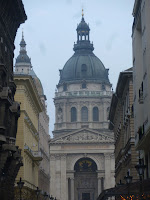

We have no history in North America. Sometimes we like to pretend we do, like when we go to Old North Church in Boston and dream about the Revolutionary War and how brave Paul Revere must have been to go out there and warn all of those British that they weren't going to take our guns [sic]. My parents live in a house in Rhode Island that has been around since the early 17th century and sometimes it feels like it's about to fall down around their ears with the weight of all of the years it has seen. But really, when we look at Europe, we realize how we have just been fooling ourselves the whole time. In Konstanz, there are whole streets of houses that were first mentioned in sources in the 1300's and were around for who knows how long since then, making my Memere's house look like Gatsby's nouveau riche manor of the American dream. At lot has happened in the past three hundred years on our side of the Atlantic, but our history books will always be dwarfed by the thousands of years that western civilization has had to build up in Europe.
In no city I visited was this more clear than in Rome. Unfortunately, I was only in the Eternal City for about two and a half days, which didn't get me time to do much more than see the things one is 'supposed' to see on a run-through, snap a few photos basis, but it was very influenced nonetheless. Particularly in the case of the most popular tourist attractions, you've really already seen them enough, from photos, movies, and the like, that being there in person is as much a sense of odd deja vu as a new experience. Don't get me wrong, it's certainly awesome to finally see the Colosseum or walk across St. Peter's Square, but for me at least, it's more a feeling of selfish satisfaction at finally having seen a place I heard so much about, rather than an appreciation for the place itself.
For me the best part of being in Rome was just absorbing the atmosphere, because the city just feels Old. By the time I went, I had already been in Europe for about six months, so I thought I was over the sense of exhilaration at a building that has existed since before Columbus sailed the ocean blue. In Rome, however, the feeling is particularly acute, particularly since the architecture at every turn seems to show evidence of just about every stage of human history since the birth of Christ. Roman ruins and even well preserved castles bump up against medieval churches whose iconography still seem to betray traces of Byzantine influence and high Renaissance palaces that clearly inspired the backgrounds of the famous Italian masterpaintings that you see in every art museum around the world. Just being there is an aesthetic experience of its own merits, pulling you back into reminiscences on the history and culture that formed our own collective cultural unconscious. More than any other city I visited, being in Rome feels like being in touch with the past.







